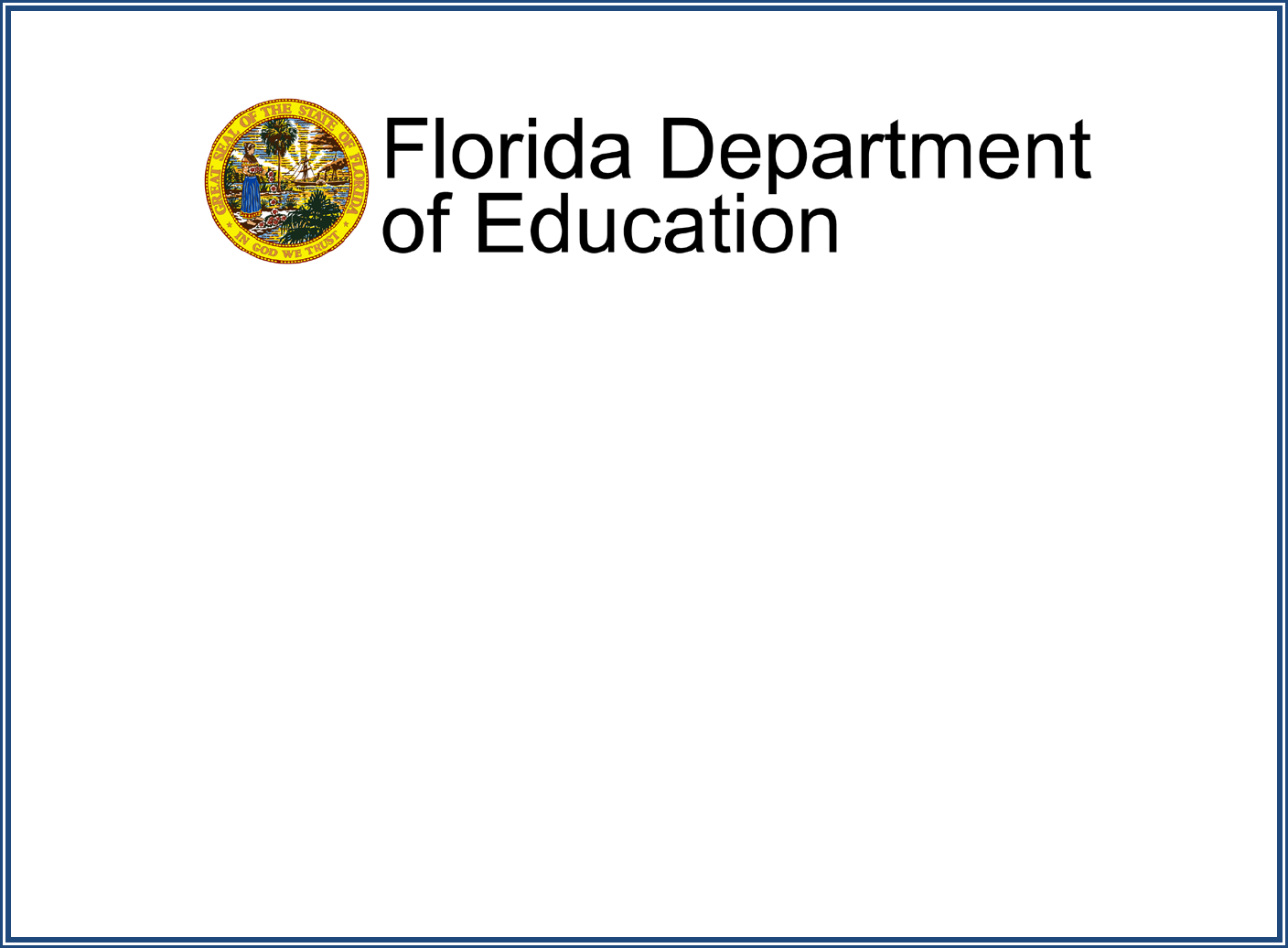
Teacher Evaluation Systems Alignment:
The Florida Educator Accomplished Practices (FEAPs),
Dr. Robert Marzano and Charlotte Danielson
May 2012
Contributors:
Jessica Weiss; Hillsborough County
Tricia McManus; Hillsborough County
Kay Bonti; Hillsborough County
Shaylia McRae; Hillsborough County
Sandra Robinson; Hillsborough County
Debbie Terry; Collier County
Carla Moore; St. Lucie County
Debbie Lucas; Orange County
Melissa Carr Ed.D.; Volusia County
Gwynn Cadwallader; Putnam County
Mary Beth Hedstrom; Putnam County
Sharon Moffitt, Ph. D; Broward County
Debbie Cooke; Florida Association
of Staff Development
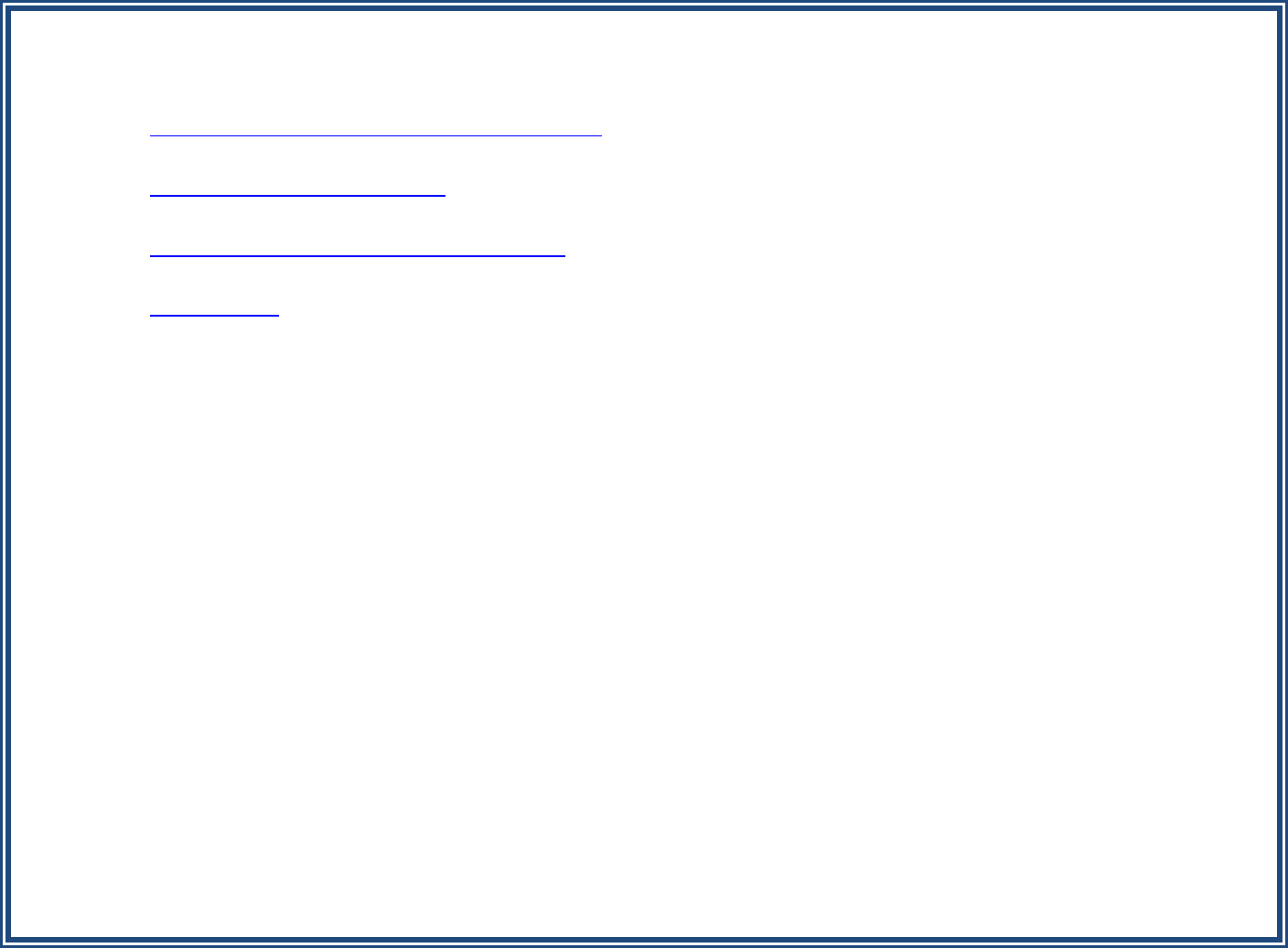
Table of Contents
Instructional Design and Lesson Planning . . . . . . . . . . . . . . . . . . . . . . . . . . . . . . . . . . . . . . . . . . . . 3
The Learning Environment . . . . . . . . . . . . . . . . . . . . . . . . . . . . . . . . . . . . . . . . . . . . . . . . . . . . . . . . . . 8
Instructional Delivery and Facilitation . . . . . . . . . . . . . . . . . . . . . . . . . . . . . . . . . . . . . . . . . . . . . . 14
Assessment . . . . . . . . . . . . . . . . . . . . . . . . . . . . . . . . . . . . . . . . . . . . . . . . . . . . . . . . . . . . . . . . . . . . . . . . 21
This document was developed as part of a Community of Practice (CoP) focused on continuing improvement of Florida school
districts’ capacities for supporting educator professional learning through evaluation processes.
As a component in the CoP, a multi-district “Evaluation Workgroup” engaged in analysis of the use of evaluation instruments to guide
improvement in teacher and school leader proficiency on practices that positively impact student learning growth. The workgroup is
comprised of Florida educators with deep understanding of one of the following evaluation instruments:
• The Florida State Model for Classroom Teacher Evaluation (based on Dr. Robert Marzano’s meta-analyses)
• The Framework for Teaching developed by Dr. Charlotte Danielson
As of 2012, the state model teacher evaluation instrument (Marzano-based) is used in 44 percent of Florida districts and lab schools and
the Danielson model is used in 20 percent. Most of the remaining district systems use models that incorporate elements of one or both of
these models. Over 90 percent of Florida’s classroom teacher evaluation instruments contain elements from the Marzano and/or
Danielson systems.
As Florida districts examine the impact of their classroom teacher evaluation instruments and explore revisions over the next several
years, sharing the strengths and weakness of the various models in use is part of the Community of Practice process. As districts
address revision of their systems, they must retain alignment with the Florida Educator Accomplished Practices (FEAPs). To support
district sharing processes, the Evaluation Workgroup has compiled this document to illustrate how the Marzano and Danielson
models align to the FEAPs.
Design: Alignment to the FEAPs is shown in a three column format. Column 1 cites text from the FEAPs. Column 2 cites text from the State
Model aligned to that segment of the FEAPs (using the numbering system in the state model). Column 3 cites text from Danielson’s
Framework for Teaching aligned to that segment of the FEAPs (using numbering from the most commonly used Danielson model). At the
end of each section, a row entitled “Commonalities and Conclusions” notes areas where the two models address similar purposes.

1. Instructional Design and Lesson Planning Table of Contents
Applying concepts from human development and learning theories, the effective educator consistently:
FEAPs
Marzano
RE: Routine Events, C: Content, EOS: Enacted on the Spot
Danielson
a. Aligns instruction
with state-adopted
standards at the
appropriate level of
rigor
Domain 1: Classroom Strategies and Behaviors
•
RE 1 Providing clear learning goals and scales
• C 1 Identifying critical information
Domain 2: Planning and Preparing
• 2.1.1 Planning and preparing for effective
scaffolding within lessons
• 2.1.2 Planning and preparing for lessons
within units that progress toward a deep
understanding and transfer of content
• 2.1.3 Planning and preparing for appropriate
attention to established content standards
• 2.2.1 Planning and preparing for the use of
available traditional resources for upcoming
units and lessons (e.g., manipulatives, video
tapes)
• 2.2.2 Planning for the use of available
technology such as interactive white boards,
voting technologies and one-to-one computer
1a Knowledge of Content and Pedagogy
•
Knowledge of content and the structure of the
discipline
• Knowledge of prerequisite relationships
• Knowledge of content-related pedagogy
1b Knowledge of Students
• Knowledge of child and adolescent
development
• Knowledge of the learning process
• Knowledge of students’ skills, knowledge and
language proficiency
• Knowledge of students’ special needs
1c Setting Instructional Outcomes
• Value, sequence and alignment
• Suitability for diverse learners
1d Demonstrating Knowledge of Resources and
Technology
• Resources and technology to extent content
knowledge and pedagogy
1e Designing Coherent Instruction
• Learning activities
•
Instructional groups
• Lesson and unit structure
Commonalities and
Conclusions:
Teachers should have a solid understanding of what they are teaching and what students are to learn
(the Common Core and Next Generation Sunshine State Standards). Learning goals should be created to
align with standards and student needs.
3
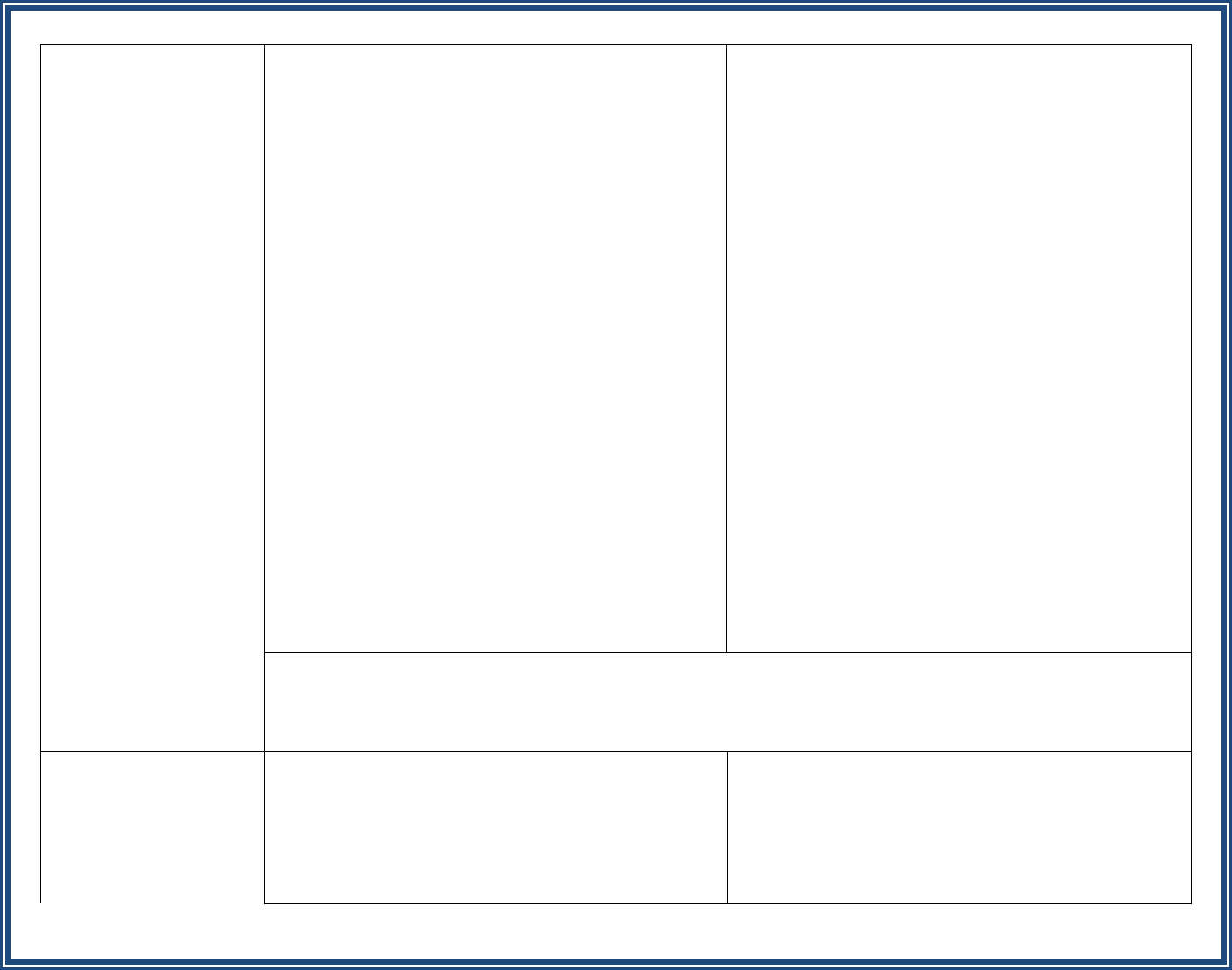
b. Sequences lessons
and concepts to
ensure coherence and
required prior
knowledge
Domain 1: Classroom Strategies and Behaviors
•
RE 1 Providing clear learning goals and scales
• RE 2 Tracking student progress
• RE 3 Celebrating success
Domain 2: Planning and Preparing
• 2.1.1 Planning and preparing for effective
scaffolding within lessons
• 2.1.2 Planning and preparing for lessons
within units that progress toward a deep
understanding and transfer of content
• 2.1.3 Planning and preparing for appropriate
attention to established content standards
1a Knowledge of Content and Pedagogy
•
Knowledge of content and the structure of the
discipline
• Knowledge of prerequisite relationships
• Knowledge of content-related pedagogy
1b Knowledge of Students
• Knowledge of child and adolescent
development
• Knowledge of the learning process
• Knowledge of students’ skills, knowledge and
language proficiency
• Knowledge of students’ special needs
1c Setting Instructional Outcomes
• Value, sequence and alignment
• Clarity and balance
• Suitability for diverse learners
1e Designing Coherent Instruction
• Learning activities
• Instructional materials and resources
•
Instructional groups
• Lesson and unit structure
Commonalities and
Conclusions:
Lessons must lead toward mastery of standards in a logical and coherent manner. Lessons should access
and expand upon prior knowledge with an understanding of prerequisite relationships within the
content area and across the curriculum. Lessons should be planned in a manner that is cohesive and
build upon each other to develop student prior knowledge in preparation for future learning.
c. Designs instruction
for students to achieve
mastery
Domain 1: Classroom Strategies and Behaviors
•
C 10 Organizing students to practice and
deepen knowledge
• C 16 Organizing students for cognitively
complex tasks
1b Knowledge of Students
•
Knowledge of child and adolescent
development
• Knowledge of the learning process
•
Knowledge of students’ skills, knowledge and
language proficiency
4

Domain 2: Planning and Preparing
• 2.1.1 Planning and preparing for effective
scaffolding within lessons
• 2.1.2 Planning and preparing for lessons
within units that progress toward a deep
understanding and transfer of content
• 2.1.3 Planning and preparing for appropriate
attention to established content standards
• 2.3.1 Planning and preparing for the needs of
English language learners
• 2.3.2 Planning and preparing for the needs of
students receiving special education
• 2.3.3 Planning and preparing for the needs of
students who come from home environments
that offer little support for schooling
•
Knowledge of students’ interests and cultural
heritage
• Knowledge of students’ special needs
1e Designing Coherent Instruction
• Learning activities
• Instructional materials and resources
• Instructional groups
• Lesson and unit structure
1f Designing Student Assessments
• Congruence with instructional outcomes
• Criteria and standards
•
Design of formative assessments
• Use for planning
Commonalities and
Conclusions:
With an understanding of curriculum standards and individual student needs, the teacher should
develop and implement lessons that will facilitate achievement of mastery.
d. Selects appropriate
formative assessments
to monitor learning
Domain 1: Classroom Strategies and Behaviors
•
RE 1 Providing clear learning goals and scales
• RE 2 Tracking student progress
1f Designing Student Assessments
•
Congruence with instructional outcomes
• Criteria and standards
•
Design of formative assessments
• Use for planning
Commonalities and
Conclusions:
The teacher should plan to track student progress with continuous monitoring and formative
assessments of student learning throughout the instructional process.
e. Uses diagnostic
student data to plan
lessons
Domain 1: Classroom Strategies and Behaviors
•
RE 1 Providing clear learning goals and scales
• RE 2 Tracking student progress
• RE 3 Celebrating success
• C 11 Homework
• EOS 16 Demonstrating value and respect for
low expectancy students
•
EOS 17 Asking questions of low expectancy
students
1b Knowledge of Students
•
Knowledge of child and adolescent
development
• Knowledge of the learning process
• Knowledge of students’ skills, knowledge and
language proficiency
• Knowledge of students’ interests and cultural
heritage
•
Knowledge of students’ special needs
5

Domain 2: Planning and Preparing
• 2.3.1 Planning and preparing for the needs of
English language learners
• 2.3.2 Planning and preparing for the needs of
students receiving special education
• 2.3.3 Planning and preparing for the needs of
students who come from home environments
that offer little support for schooling
1e Designing Coherent Instruction
• Learning activities
• Instructional materials and resources
• Instructional groups
• Lesson and unit structure
1f Designing Student Assessments
• Congruence with instructional outcomes
• Criteria and standards
• Design of formative assessments
• Use for planning
3d Using Assessment in Instruction
• Monitoring of student learning
• Feedback to students
•
Student self-assessment and monitoring of
progress
Commonalities and
Conclusions:
Using specific data that allows for the analysis of student progress and learning, the teacher should plan
lessons that are appropriate and differentiated to meet individual student needs.
f. Develops learning
experiences that
require students to
demonstrate a variety
of applicable skills and
competencies
Domain 1: Classroom Strategies and Behaviors
•
C 2 Organizing students to interact with new
knowledge
• C 10 Organizing students to practice and
deepen knowledge
• C 12 Examining similarities and differences
• C 13 Examining errors in reasoning
• C 14 Practicing skills, strategies and
processes
• C 15 Revising knowledge
• C 16 Organizing students for cognitively
complex tasks
1e Designing Coherent Instruction
•
Learning activities
• Instructional materials and resources
• Instructional groups
• Lesson and unit structure
6
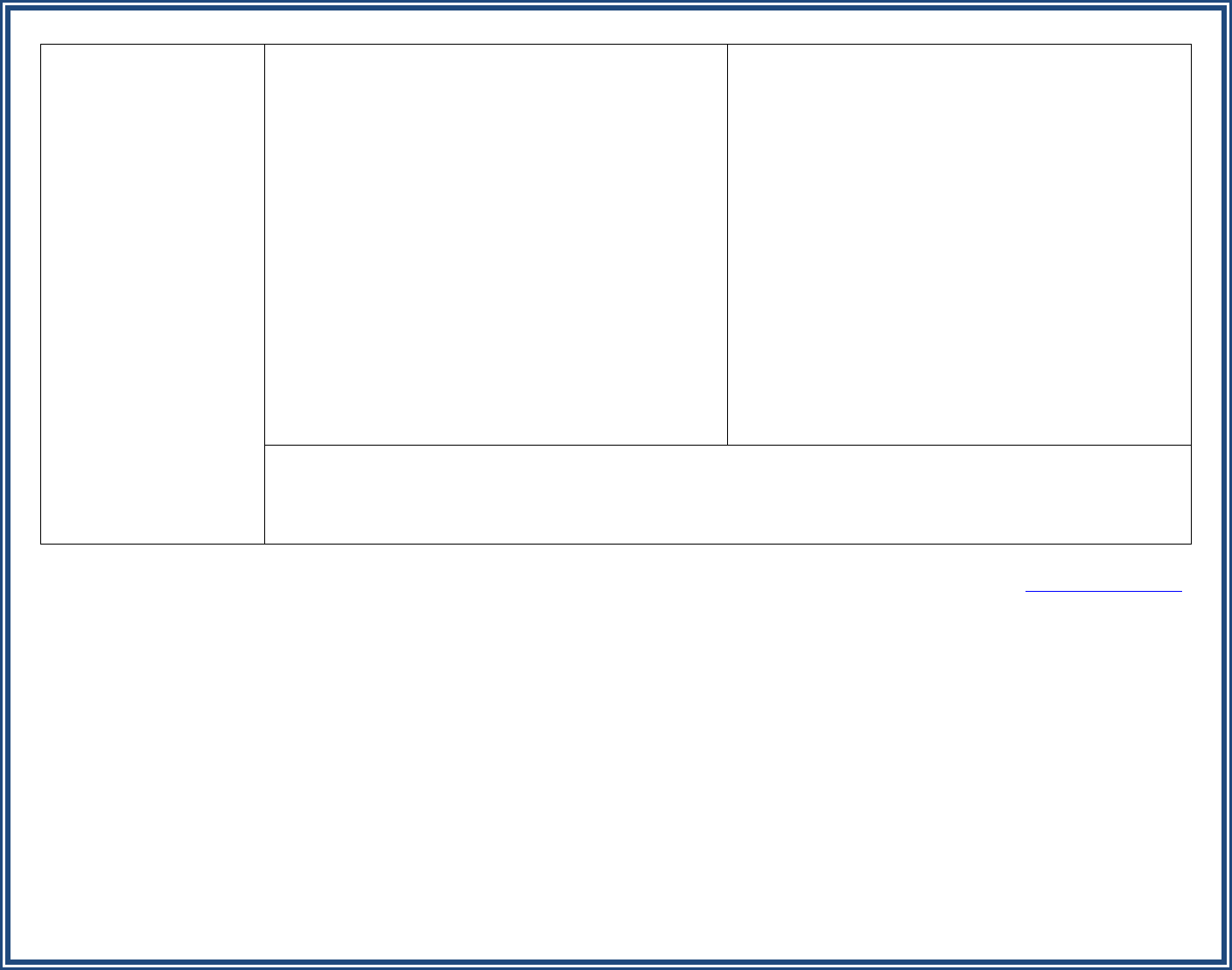
Domain 2: Planning and Preparing
• 2.2.1 Planning and preparing for the use of
available traditional resources for upcoming
units and lessons (e.g., manipulatives, video
tapes)
• 2.2.2 Planning for the use of available
technology such as interactive white boards,
voting technologies and one-to-one computer
• 2.3.1 Planning and preparing for the needs of
English language learners
• 2.3.2 Planning and preparing for the needs of
students receiving special education
• 2.3.3 Planning and preparing for the needs of
students who come from home environments
that offer little support for schooling
Commonalities and
Conclusions:
Learning experiences should be designed to allow students to process and apply learning in a manner
that is appropriate based on student needs and provides for continued learning through expansion.
Learning experiences should include a variety of skills and competencies that lead to mastery of
academic standards.
Table of Contents
7
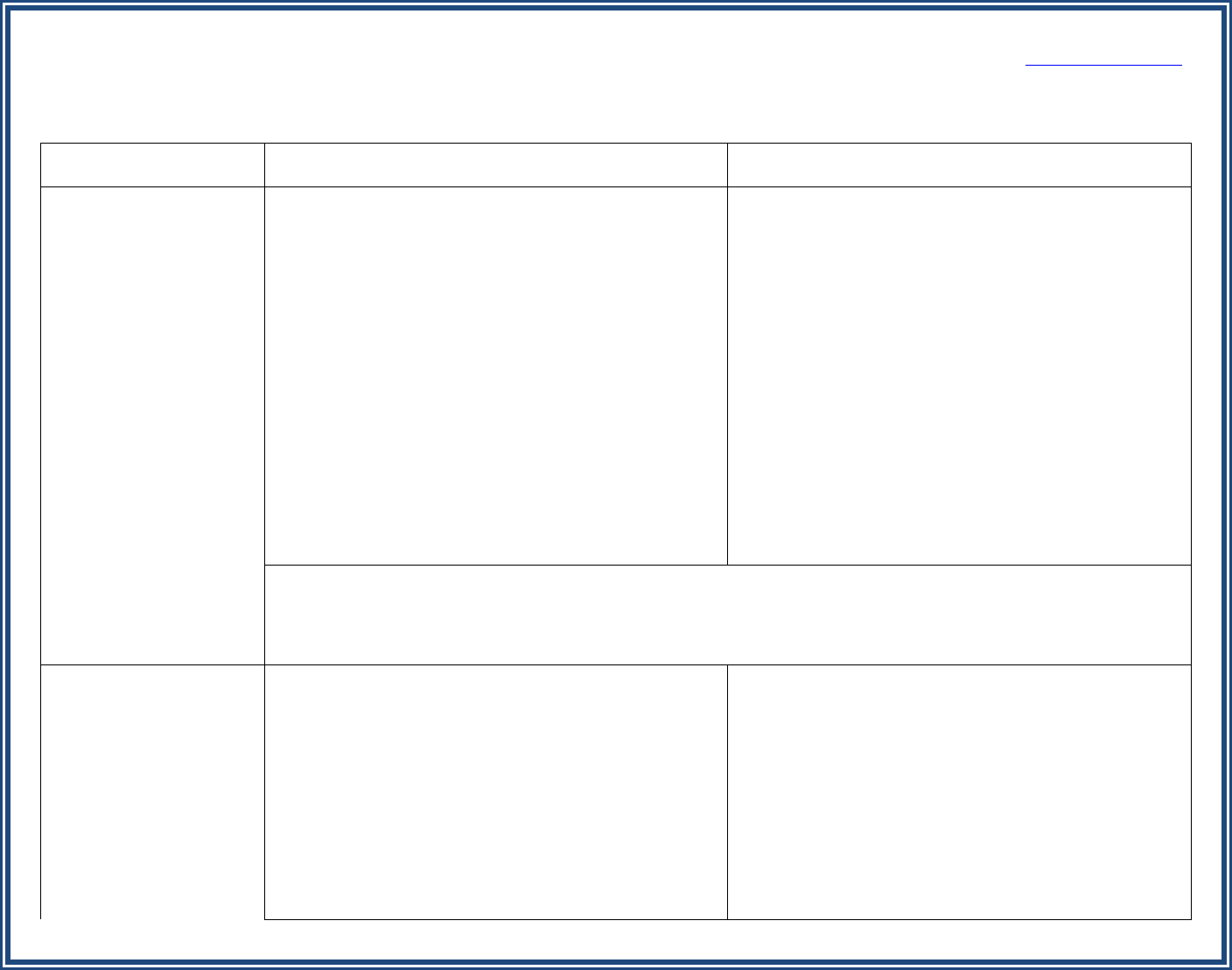
2. The Learning Environment Table of Contents
To maintain a student centered learning environment that is safe, organized, equitable, flexible, inclusive and
collaborative, the effective educator consistently:
FEAPs
Marzano
RE: Routine Events, C: Content, EOS: Enacted on the Spot
Danielson
a. Organizes, allocates,
and manages
resources of time,
space and attention
Domain 1: Classroom Strategies and Behaviors
•
RE 4 Establishing classroom rules and
procedures
• RE 5 Organizing the physical layout of the
classroom
• EOS 10 Demonstrating "withitness"
• EOS 12 Acknowledging adherence to rules
and procedures
• EOS 13 Understanding students' interests and
backgrounds
• EOS 15 Displaying objectivity and control
Domain 4: Collegiality and Professionalism
•
4.1.2 Promoting positive interactions with
students and parents
2c Managing Classroom Procedures
•
Management of instructional groups
• Management of transitions
• Management of materials and supplies
• Performance of non-instructional duties
• Supervision of volunteers and
paraprofessionals
2e Organizing Physical Space
• Safety and accessibility
• Arrangement of furniture and use of physical
resources
Commonalities and
Conclusions:
Teachers should establish and review expectations regarding rules and procedures and monitor the
extent to which students understand rules and procedures. Well-designed routines and procedures
maximize instructional time. A well-managed classroom is safe and arranged in such a manner as to
support the instructional activities.
b. Manages individual
and class behaviors
through a well-
planned management
system
Domain 1: Classroom Strategies and Behaviors
•
RE 4 Establishing classroom rules and
procedures
• RE 5 Organizing the physical layout of the
classroom
• EOS 1 Noticing when students are not
engaged
• EOS 10 Demonstrating "withitness"
•
EOS 11 Applying consequences for lack of
adherence to rules and procedures
2d Managing Student Behavior
•
Expectations
• Monitoring of student behavior
• Response to student behavior
2c Managing Classroom Procedures
• Management of instructional groups
• Management of transitions
•
Management of materials and supplies
• Performance of non-instructional duties
8

• EOS 12 Acknowledging adherence to rules
and procedures
•
EOS 15 Displaying objectivity and control
• Supervision of volunteers and
paraprofessionals
Commonalities and
Conclusions:
Students learn best in a calm and structured environment with ongoing monitoring of routines,
procedures and standards of conduct, which contribute to the sense of order and predictability.
c. Conveys high
expectations to all
students
Domain 1: Classroom Strategies and Behaviors
•
RE 1 Providing clear learning goals and scales
• RE 2 Tracking student progress
• RE 3 Celebrating success
• C 1 Identifying critical information
• C 2 Organizing students to interact with new
knowledge
•
EOS 16 Demonstrating value and respect for
low expectancy students
2b Establishing a culture for learning
•
Importance of content
• Expectations for learning and
achievement
• Student pride in work
Commonalities and
Conclusions:
The atmosphere in the classroom reflects the educational importance of the work undertaken by both
the students and the teacher. There should be high expectations for all students in which learning and
hard work are valued. The student’s current status and knowledge-gain relevant to the learning goal
should be monitored and the efforts and behaviors that led to growth are to be celebrated.
d. Respects students’
cultural linguistic and
family background
Domain 1: Classroom Strategies and Behaviors
•
RE 1 Providing clear learning goals and scales
• RE 2 Tracking student progress
• RE 3 Celebrating success
• C 1 Identifying critical information
• C 2 Organizing students to interact with new
knowledge
• EOS 14 Using verbal and nonverbal behaviors
that indicate affection for students
• EOS 16 Demonstrating value and respect for
low expectancy students
• EOS 17 Asking questions of low expectancy
students
• EOS 18 Probing incorrect answers with low
expectancy students
• EOS 6 Demonstrating intensity and
2a Creating an Environment of Respect and
Rapport
• Teacher interaction with students
• Student interactions with one another
9

enthusiasm
Commonalities and
Conclusions:
In a respectful classroom, all students feel valued and safe. The teacher should manage relationships
with students and among students, ensuring that verbal and nonverbal interactions are positive and
supportive. Differences should be celebrated and valued.
e. Models clear,
acceptable oral and
written
communication skills
Domain 1: Classroom Strategies and Behaviors
•
RE 1 Providing clear learning goals and scales
• RE 2 Tracking student progress
• RE 4 Establishing classroom rules and
procedures
• EOS 10 Demonstrating "withitness"
• EOS 11 Applying consequences for lack of
adherence to rules and procedures
• EOS 12 Acknowledging adherence to rules
and procedures
• C 1 Identifying critical information
• C 2 Organizing students to interact with new
knowledge
•
C 3 Previewing new content
• C 4 Chunking content into “digestible bites"
3a Communicating with Students
•
Expectations for learning
• Directions and procedures
• Explanations of content
• Use of oral and written language
Commonalities and
Conclusions:
Teachers should make the purpose of learning clear to students, provide clear directions for classroom
activities and monitor students’ understanding of the expectations. Teachers’ use of language should be
vivid, rich, and error free, affording the opportunity for students to hear language used effectively and to
extend their own vocabularies.
f. Maintains a climate
of openness, inquiry,
fairness and support
Domain 1: Classroom Strategies and Behaviors
•
RE 1 Providing clear learning goals and scales
• RE 2 Tracking student progress
• RE 3 Celebrating success
• EOS 14 Using verbal and nonverbal behaviors
that indicate affection for students
• EOS 16 Demonstrating value and respect for
low expectancy students
• EOS 17 Asking questions of low expectancy
students
•
EOS 18 Probing incorrect answers with low
2a Creating an Environment of Respect and
Rapport
• Teacher interactions with students
• Student interactions with one another
2b Establishing a Culture for Learning
• Importance of the content
• Expectations for learning and achievement
• Student pride in work
10

expectancy students
•
C 1 Identifying critical information
• C 2 Organizing students to interact with new
knowledge
Domain 4: Collegiality and Professionalism
•
4.1.2 Promoting positive interactions with
students and parents
Commonalities and
Conclusions:
Teachers should create an atmosphere of rigorous learning in a risk free environment, using students’
interests and backgrounds to produce a climate of acceptance and community. Teachers should monitor
the impact of the environment on student learning.
g. Integrates current
information and
communication
technologies
Domain 2: Planning and Preparing
•
2.2.1 Planning and preparing for the use of
available traditional resources for upcoming
units and lessons (e.g., manipulatives, video
tapes)
• 2.2.2 Planning for the use of available
technology such as interactive white boards,
voting technologies and one-to-one computer
Technology is a common theme reflected in
Domain 1 (Planning and Preparation), Domain 3
(Instruction) and Domain 4 (Professional
Responsibilities).
Commonalities and
Conclusions:
Teachers should identify and use available resources to include technologies that enhance students’
understanding of content.
h. Adapts the learning
environment to
accommodate the
differing needs and
diversity of students
Domain 1: Classroom Strategies and Behaviors
•
RE 1 Providing clear learning goals and scales
• RE 2 Tracking student progress
• RE 3 Celebrating success
• RE 4 Establishing classroom rules and
procedures
• RE 5 Organizing the physical layout of the
classroom
• C 1 Identifying critical information
• C 2 Organizing students to interact with new
knowledge
•
C 10 Organizing students to practice and
deepen new knowledge
Accommodating diverse student needs is
reflected in Domain 1 (Planning and Preparation)
and Domain 3 (Instruction).
11

• C 16 Organizing students for cognitively
complex tasks
• EOS 1 Noticing when students are not
engaged
• EOS 5 Maintaining a lively pace
• EOS 6 Demonstrating intensity and
enthusiasm
• EOS 10 Demonstrating "withitness"
• EOS 11 Applying consequences for lack of
adherence and adherence to rules and
procedures
• EOS 12 Acknowledging adherence to rules
and procedures
• EOS 13 Understanding students' interests and
backgrounds
• EOS 14 Using verbal and nonverbal behaviors
that indicate affection for students
• E0S 15 Displaying objectivity and control
• EOS 16 Demonstrating value and respect for
low expectancy students
• EOS 17 Asking questions of low expectancy
students
• EOS 18 Probing incorrect answers with low
expectancy students
Domain 2: Planning and Preparing
• 2.1.1 Planning and preparing for effective
scaffolding within lessons
• 2.1.2 Planning and preparing for lessons
within units that progress toward a deep
understanding and transfer of content
• 2.1.3 Planning and preparing for appropriate
attention to established content standards
•
2.3.1 Planning and preparing for the needs of
12

English language learners
•
2.3.2 Planning and preparing for the needs of
students receiving special education
• 2.3.3 Planning and preparing for the needs of
students who come from home environments
that offer little support for schooling
Commonalities and
Conclusions:
Multiple tiers of support are planned and implemented. Students with diverse and unique needs should
be considered when planning lessons and identifying resources that will ensure their understanding.
Adaptations to lesson-based tracking of student progress are essential to meeting diverse needs.
i. Utilizes current and
emerging assistive
technologies that
enable students to
participate in high-
quality
communication
interactions and
achieve their
educational goals
Domain 2: Planning and Preparing
•
2.2.1 Planning and preparing for the use of
available traditional resources for upcoming
units and lessons (e.g., manipulatives, video
tapes)
• 2.2.2 Planning for the use of available
technology such as interactive white boards,
voting technologies and one-to-one computer
Technology is a common theme reflected in
Domain 1 (Planning and Preparation), Domain 3
(Instruction), and Domain 4 (Professional
Responsibilities).
Commonalities and
Conclusions:
Teachers should identify and use technologies that encourage participation and enhance students’
understanding of content.
Table of Contents
13

3. Instructional Delivery and Facilitation Table of Contents
The effective educator consistently utilizes a deep and comprehensive knowledge of the subject taught to:
FEAPs
Marzano
RE: Routine Events, C: Content, EOS: Enacted on the Spot
Danielson
a. Deliver engaging
and challenging
lessons
Domain 1: Classroom Strategies and Behaviors
•
EOS 10 Demonstrating "withitness"
• EOS 11 Applying consequences for lack of
adherence to rules and procedures
• EOS 12 Acknowledging adherence to rules
and procedures
• C 2 Organizing students to interact with new
knowledge
• C 10 Organizing students to practice and
deepen knowledge
• C 16 Organizing students for cognitively
complex tasks
• EOS 5 Maintaining a lively pace
Domain 2: Planning and Preparing
• 2.1.1 Planning and preparing for effective
scaffolding within lessons
• 2.1.2 Planning and preparing for lessons
within units that progress toward a deep
understanding and transfer of content
• 2.2.1 Planning and preparing for the use of
available traditional resources for upcoming
units and lessons (e.g., manipulatives, video
tapes)
• 2.2.2 Planning for the use of available
technology such as interactive white boards,
voting technologies and one-to-one computer
• 2.3.1 Planning and preparing for the needs of
English language learners
3c Engaging Students in Learning
•
Activities and Assignments
• Grouping of Students
• Instructional Materials and Resources
• Structure and Pacing
14
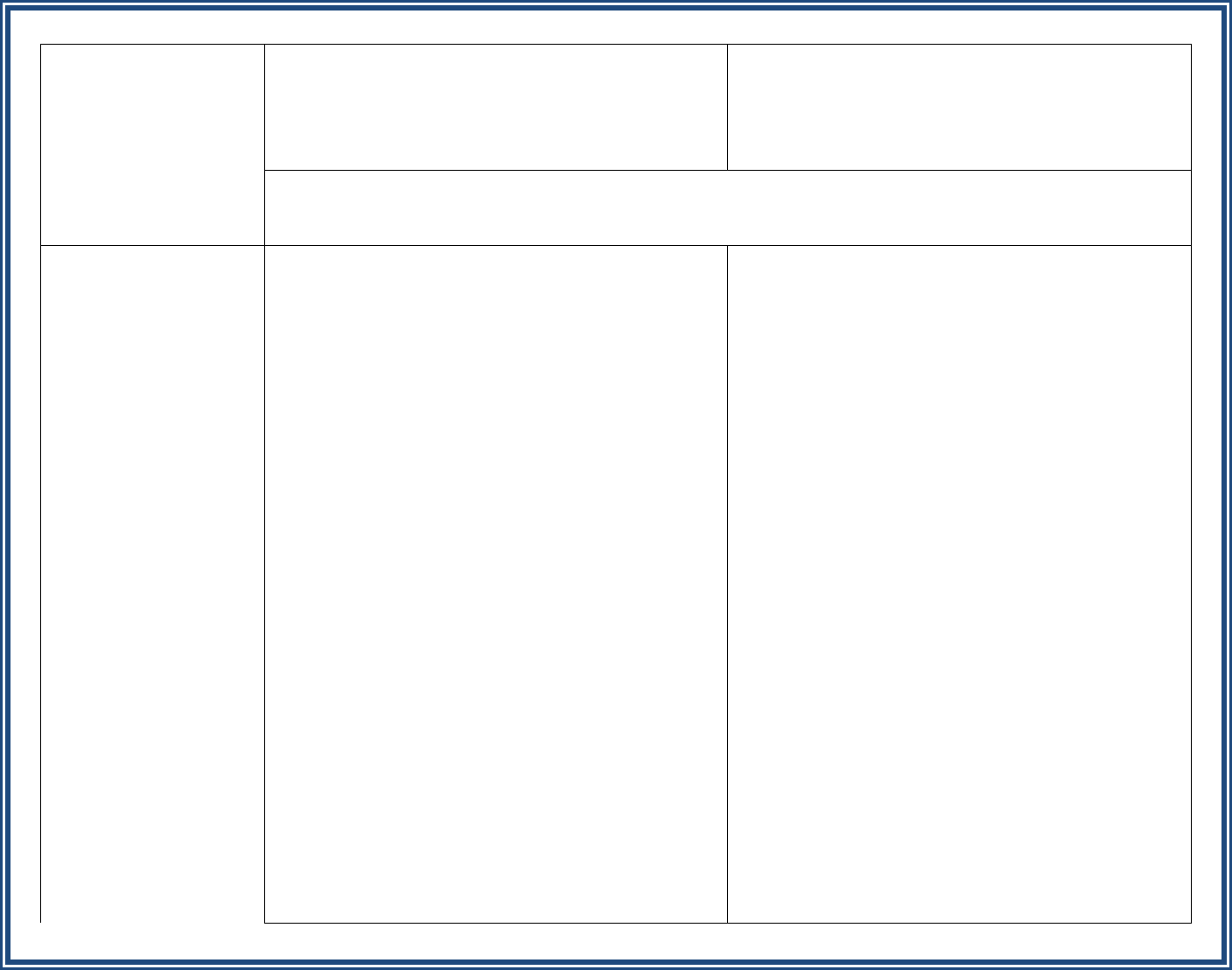
• 2.3.2 Planning and preparing for the needs of
students receiving special education
• 2.3.3 Planning and preparing for the needs of
students who come from home environments
that offer little support for schooling
Commonalities and
Conclusions:
Engagement leads to learning. Rigor leads to deep learning. Lessons should be appropriate to the levels
and needs of students and organized in a manner that ensures students are active in intellectually
rigorous learning.
b. Deepen and enrich
students’
understanding
through content area
literacy strategies,
verbalization of
thought and
application of the
subject matter
Domain 1: Classroom Strategies and Behaviors
•
C 2 Organizing students to interact with new
knowledge
• C 10 Organizing students to practice and
deepen knowledge
• C 16 Organizing students for cognitively
complex tasks
• EOS 10 Demonstrating "withitness"
• EOS 11 Applying consequences for lack of
adherence to rules and procedures
• EOS 12 Acknowledging adherence to rules
and procedures
Domain 2: Planning and Preparing
• 2.2.1 Planning and preparing for the use of
available traditional resources for upcoming
units and lessons (e.g., manipulatives, video
tapes)
• 2.2.2 Planning for the use of available
technology such as interactive white boards,
voting technologies and one-to-one computer
• 2.3.1 Planning and preparing for the needs of
English language learners
• 2.3.2 Planning and preparing for the needs of
students receiving special education
3c Engaging Students in Learning
•
Activities and Assignments
• Grouping of Students
• Instructional Materials and Resources
• Structure and Pacing
15
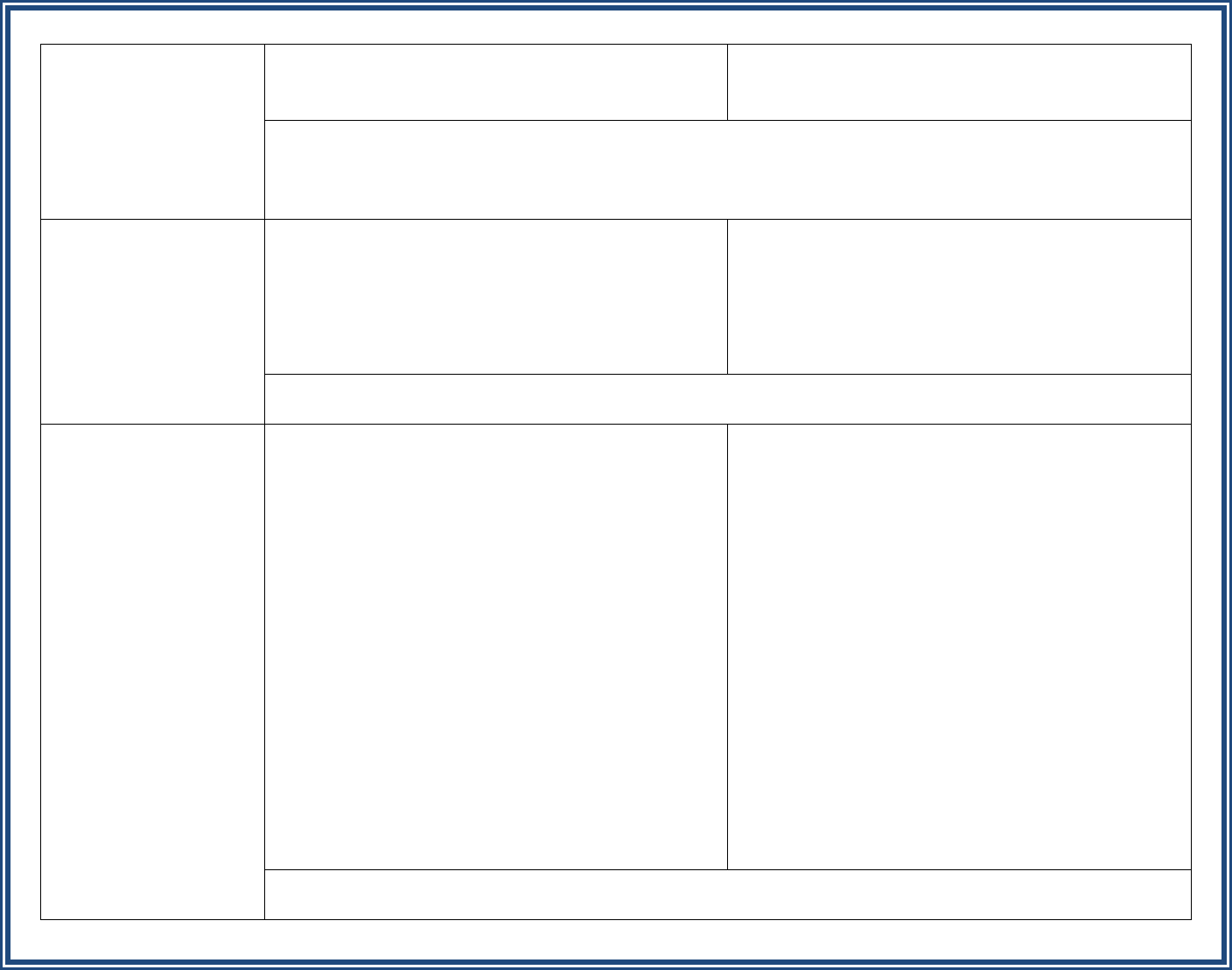
• 2.3.3 Planning and preparing for the needs of
students who come from home environments
that offer little support for schooling
Commonalities and
Conclusions:
Literacy and thinking skills are applied across the grades and curriculum. Lessons should include
strategies that allow students to gain an understanding of content as well as the connections with and
among other content areas and real-world applications. Students should be afforded the opportunity to
process and reflect on learning through application.
c. Identify gaps in
students’ subject
matter knowledge
Domain 1: Classroom Strategies and Behaviors
•
RE 1 Providing clear learning goals and scales
• RE 2 Tracking student progress
• RE 3 Celebrating success
•
EOS 3 Managing response rates
• C 7 Recording and representing knowledge
3d Using Assessment in Instruction
•
Assessment criteria
• Monitoring of student learning
• Feedback to students
•
Student self-assessment and monitoring of
progress
Commonalities and
Conclusions:
Teachers should use various assessment techniques, both formal and informal, to understand student
misconceptions and/or content that should be addressed and retaught.
d. Modify instruction
to respond to
preconceptions or
misconceptions
Domain 1: Classroom Strategies and Behaviors
•
EOS 1 Noticing when students are not
engaged
• EOS 3 Managing response rates
• EOS 5 Maintaining a lively pace
• EOS 8 Providing opportunities for students to
talk about themselves
• EOS 13 Understanding students' interests and
backgrounds
Domain 2: Planning and Preparing
• 2.3.1 Planning and preparing for the needs of
English language learners
• 2.3.2 Planning and preparing for the needs of
students receiving special education
• 2.3.3 Planning and preparing for the needs of
students who come from home environments
that offer little support for schooling
3e Demonstrating Flexibility and Responsiveness
•
Lesson adjustment
• Response to students
Commonalities and
Conclusions:
Based on monitoring student understanding, assessment results and data, teachers should make
accommodations to instruction and plan future instruction to address students’ areas of need.
16
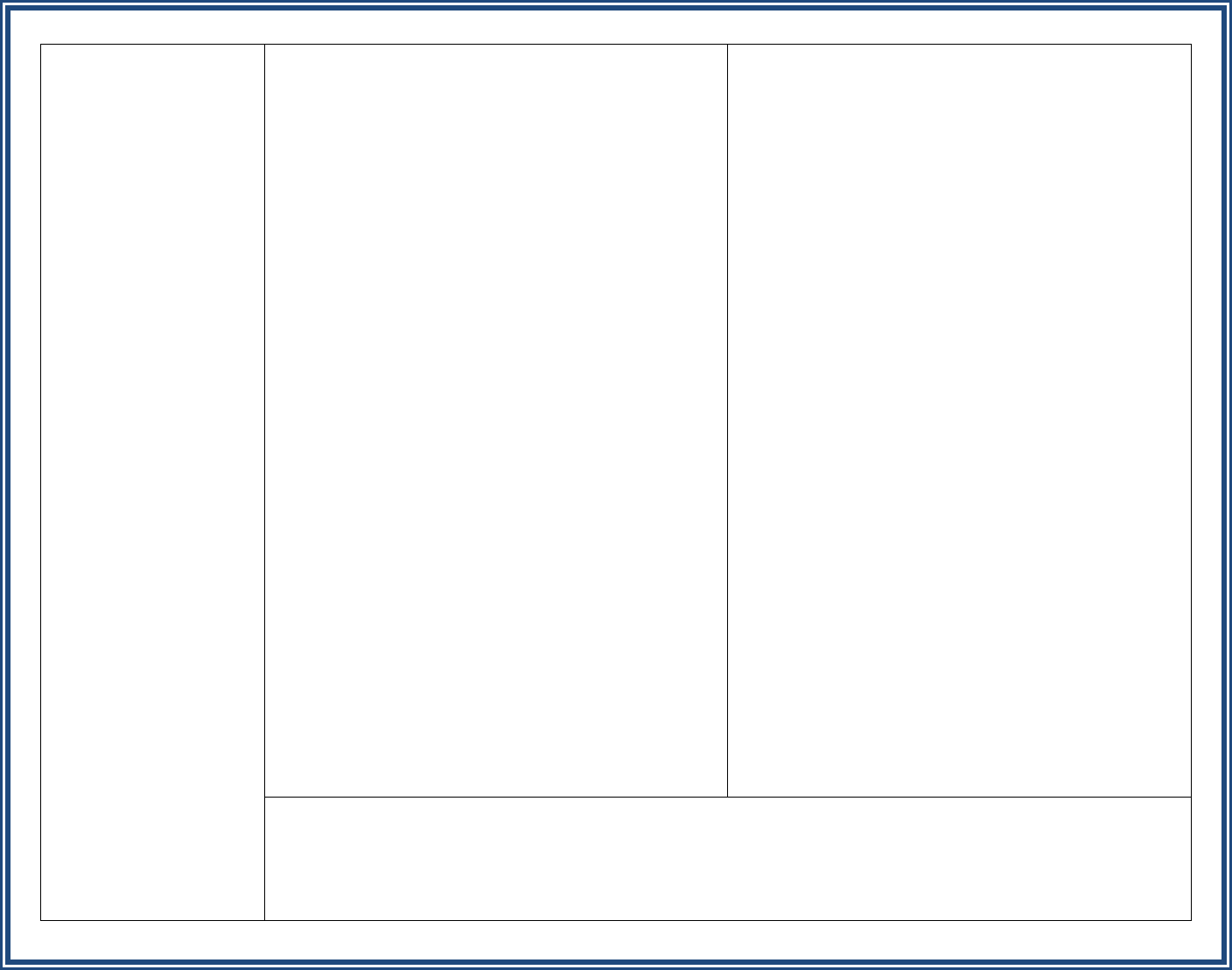
e. Relate and integrate
the subject matter
with other disciplines
and life experiences
Domain 1: Classroom Strategies and Behaviors
•
C 2 Organizing students to interact with new
knowledge
• C 10 Organizing students to practice and
deepen knowledge
• C 16 Organizing students for cognitively
complex tasks
Domain 2: Planning and Preparing
• 2.1.1 Planning and preparing for effective
scaffolding within lessons
• 2.1.2 Planning and preparing for lessons
within units that progress toward a deep
understanding and transfer of content
• 2.1.3 Planning and preparing for appropriate
attention to established content standards
• 2.2.1 Planning and preparing for the use of
available traditional resources for upcoming
units and lessons (e.g., manipulatives, video
tapes)
• 2.2.2 Planning for the use of available
technology such as interactive white boards,
voting technologies and one-to-one computer
• 2.3.1 Planning and preparing for the needs of
English language learners
• 2.3.2 Planning and preparing for the needs of
students receiving special education
• 2.3.3 Planning and preparing for the needs of
students who come from home environments
that offer little support for schooling
1e Designing Coherent Instruction
•
Learning activities
• Instructional materials and resources
• Instructional groups
• Lesson and unit structure
3c Engaging Students in Learning
• Activities and Assignments
• Grouping of Students
• Instructional Materials and Resources
Commonalities and
Conclusions:
Learning experiences should allow students to make connections between and among various content
areas and subjects. Students should be afforded the opportunity to gain understanding through
practical experiences and then process and reflect on learning through application.
17
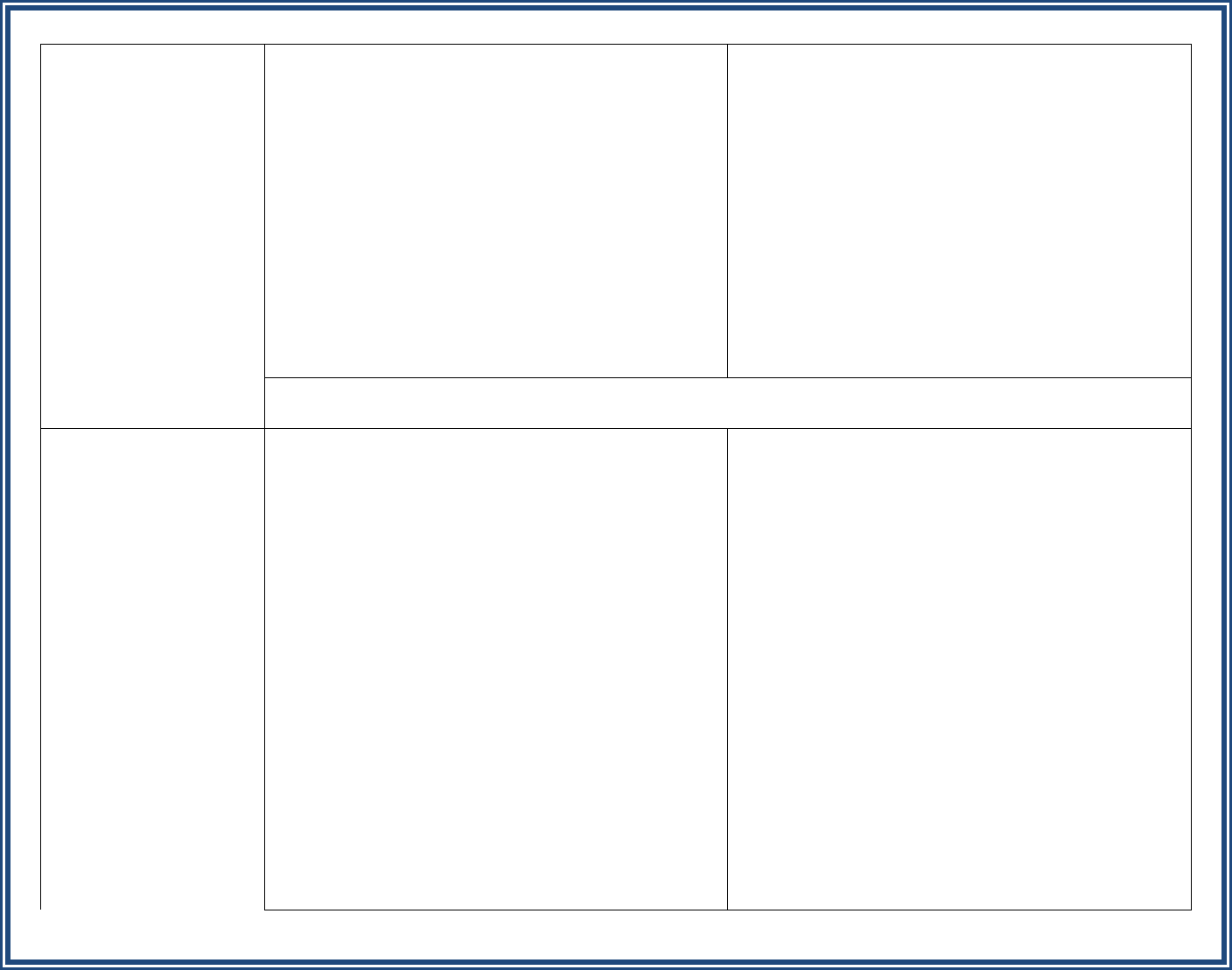
f. Employ high-order
questioning
techniques
Domain 1: Classroom Strategies and Behaviors
•
EOS 3 Managing response rates
• EOS 7 Using friendly controversy
• C 5 Processing new information
• C 6 Elaborating on new information
• C 7 Recording and representing knowledge
• C 8 Reflecting on learning
• C 9 Reviewing content
• C 12 Examining similarities and differences
• C 13 Examining errors in reasoning
• C 14 Practicing skills, strategies and
processes
• C 15 Revising knowledge
3b Using Questioning and Discussion Techniques
•
Quality of questions
• Student participation
Commonalities and
Conclusions:
Students should be prompted to think critically and engage in meaningful discussions through teacher
guidance and facilitation via questioning techniques and challenges to thinking.
g. Apply varied
instructional
strategies and
resources, including
appropriate
technology, to provide
comprehensible
instruction and to
teach for student
understanding
Domain 1: Classroom Strategies and Behaviors
•
C 2 Organizing students to interact with new
knowledge
• C 10 Organizing students to practice and
deepen knowledge
• C 16 Organizing students for cognitively
complex tasks
• EOS 5 Maintaining a lively pace
• EOS 10 Demonstrating "withitness"
• EOS 11 Applying consequences for lack of
adherence to rules and procedures
• EOS 12 Acknowledging adherence to rules
and procedures
Domain 2: Planning and Preparing
• 2.1.1 Planning and preparing for effective
scaffolding within lessons
•
2.1.2 Planning and preparing for lessons
within units that progress toward a deep
1a Knowledge of Content and Pedagogy
•
Knowledge of content-related pedagogy
1d Demonstrating Knowledge of Resources and
Technology
• Resources and technology for classroom use
• Resources and technology to extend content
knowledge and pedagogy
• Resources and technology for students
2e Organizing Physical Space
• Use of physical resources
3c Engaging Students in Learning
• Activities and Assignments
• Grouping of Students
• Instructional Materials and Resources
•
Structure and Pacing
18
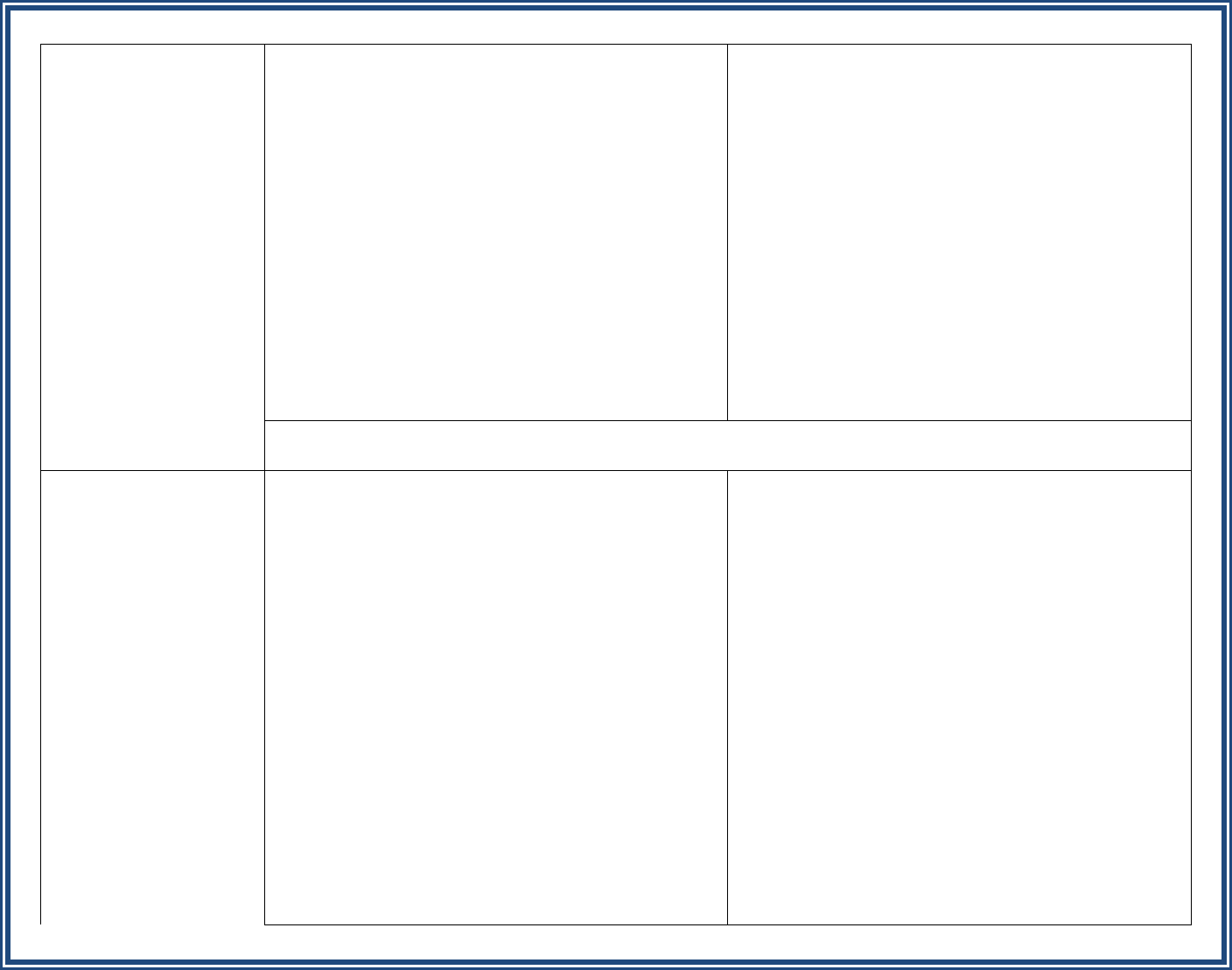
understanding and transfer of content
•
2.2.1 Planning and preparing for the use of
available traditional resources for upcoming
units and lessons (e.g., manipulatives, video
tapes)
• 2.2.2 Planning for the use of available
technology such as interactive white boards,
voting technologies and one-to-one computer
• 2.3.1 Planning and preparing for the needs of
English language learners
• 2.3.2 Planning and preparing for the needs of
students receiving special education
• 2.3.3 Planning and preparing for the needs of
students who come from home environments
that offer little support for schooling
Commonalities and
Conclusions:
Instruction should include a variety of strategies and resources as appropriate to students and their
needs.
h. Differentiate
instruction based on
an assessment of
student learning
needs and recognition
of individual
differences in students
Domain 1: Classroom Strategies and Behaviors
•
EOS 13 Understanding students' interests and
backgrounds
Domain 2: Planning and Preparing
• 2.1.1 Planning and preparing for effective
scaffolding within lessons
• 2.1.2 Planning and preparing for lessons
within units that progress toward a deep
understanding and transfer of content
• 2.1.3 Planning and preparing for appropriate
attention to established content standards
• 2.2.1 Planning and preparing for the use of
available traditional resources for upcoming
units and lessons (e.g., manipulatives, video
tapes)
•
2.2.2 Planning for the use of available
technology such as interactive white boards,
1b Demonstrating Knowledge of Students
•
Knowledge of child and adolescent
development
• Knowledge of the learning process
• Knowledge of students’ skills, knowledge and
language proficiency
• Knowledge of students’ interests and cultural
heritage
• Knowledge of students’ special needs
3d Using Assessment in Instruction
• Monitoring of student learning
• Feedback to students
• Student self-assessment and monitoring of
progress
3c Engaging Students in Learning
• Activities and Assignments
19

voting technologies and one-to-one computer
2.3.1 Planning and preparing for the needs of
English language learners
• 2.3.2 Planning and preparing for the needs of
students receiving special education
• 2.3.3 Planning and preparing for the needs of
students who come from home environments
that offer little support for schooling
• Grouping of Students
•
Instructional Materials and Resources
• Structure and Pacing
Commonalities and
Conclusions:
Teachers should utilize all available student data to determine individual student needs and adjust
instruction accordingly to meet those needs.
i. Support, encourage,
and provide
immediate and
specific feedback to
students to promote
student achievement
Domain 1: Classroom Strategies and Behaviors
•
RE 1Providing clear learning goals and scales
• RE 2 Tracking student progress
• RE 3 Celebrating success
• EOS 3 Managing response rates
•
C 7 Recording and representing knowledge
2b Establishing a Culture for Learning
•
Expectations for learning and achievement
3d Using Assessment in Instruction
• Monitoring of student learning
• Feedback to students
•
Student self-assessment and monitoring of
progress
Commonalities and
Conclusions:
Feedback should be provided to students in a positive and consistent manner that allows students to
gain an understanding of their own progress and work toward meeting goals and achieving mastery.
j. Utilize student
feedback to monitor
instructional needs
and to adjust
instruction
Domain 1: Classroom Strategies and Behaviors
•
RE 1Providing clear learning goals and scales
• RE 2 Tracking student progress
• RE 3 Celebrating success
• EOS 3 Managing response rates
• C 7 Recording and representing knowledge
3d Using Assessment in Instruction
•
Assessment criteria
• Monitoring of student learning
• Feedback to students
• Student self-assessment and monitoring of
progress
3e Demonstrating Flexibility and Responsiveness
•
Lesson adjustment
• Response to students
Commonalities and
Conclusions:
Student assessment data, both formal and informal, should be utilized to make instructional decisions
and accommodations within the lesson as it is being taught and in planning for future instruction.
Table of Contents
20
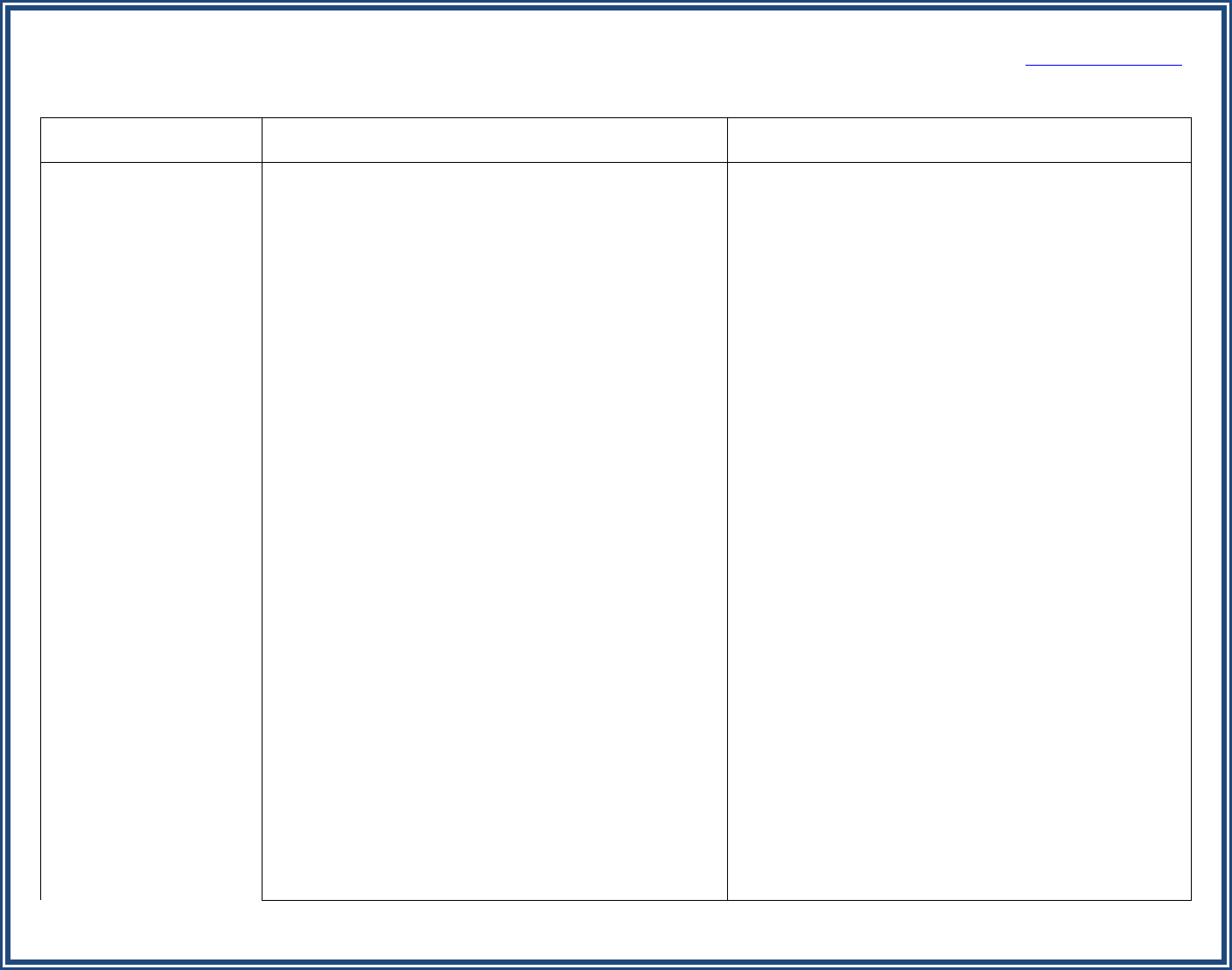
4. Assessment Table of Contents
The effective educator consistently:
FEAPs
Marzano
RE: Routine Events, C: Content, EOS: Enacted on the Spot
Danielson
a. Analyzes and
applies data from
multiple assessments
and measures to
diagnose students'
learning needs,
informs instruction
based on those needs
and drives the
learning process
Domain 1: Classroom Strategies and Behaviors
•
RE 1Providing clear learning goals and scales
• RE 2 Tracking student progress
• RE 3 Celebrating success
RE 4 Establishing classroom rules and
procedures
• C 2 Organizing students to interact with new
knowledge
• C 5 Processing new information
• C 6 Elaborating on new information
• C 7 Recording and representing knowledge
• C 8 Reflecting on learning
• C 9 Reviewing content
• C 10 Organizing students to practice and
deepen knowledge
• C12 Examining similarities and differences
• C 13 Examining errors in reasoning
• C 14 Practicing skills, strategies and processes
• C 15 Revising knowledge
• EOS 1 Noticing when students are not
engaged
• C 16 Organizing students for cognitively
complex tasks
• C 17 Engaging students in cognitively complex
tasks involving hypothesis generation and
testing
• C 18 Providing resources and guidance
•
EOS 2 Using academic games
• EOS 3 Managing response rates
1b Demonstrating Knowledge of Students
•
Knowledge of child and adolescent
development
• Knowledge of the learning process
• Knowledge of students’ skills, knowledge and
language proficiency
• Knowledge of students’ interests and cultural
heritage
• Knowledge of students’ special needs
1c Setting Instructional Outcomes
• Value, sequence and alignment
• Clarity
• Balance
• Suitability for diverse learners
1e Designing Coherent Instruction
• Learning activities
3d Using Assessment in Instruction
• Assessment criteria
• Monitoring of student learning
• Feedback to students
• Student self-assessment and monitoring of
progress
21

• EOS 4 Using physical movement
•
EOS 5 Maintaining a lively pace
• EOS 7 Using friendly controversy
• EOS 8 Provide opportunities for students to
talk about themselves
• EOS 9 Presenting unusual or intriguing
information
• EOS 10 Demonstrating "withitness"
• EOS 13 Understanding students' interests and
backgrounds
• EOS 15 Displaying objectivity and control
• EOS 16 Demonstrating value and respect for
low expectancy students
• EOS 17 Asking questions of low expectancy
students
• EOS 18 Probing incorrect answers with low
expectancy students
Domain 2: Planning and Preparing
• 2.1.1 Planning and preparing for effective
scaffolding within lessons
• 2.1.2 Planning and preparing for lessons
within units that progress toward a deep
understanding and transfer of content
• 2.2.1 Planning and preparing for the use of
available traditional resources for upcoming
units and lessons (e.g., manipulatives, video
tapes)
• 2.2.2 Planning for the use of available
technology such as interactive white boards,
voting technologies and one-to-one computer
• 2.3.1 Planning and preparing for the needs of
English language learners
• 2.3.2 Planning and preparing for the needs of
22
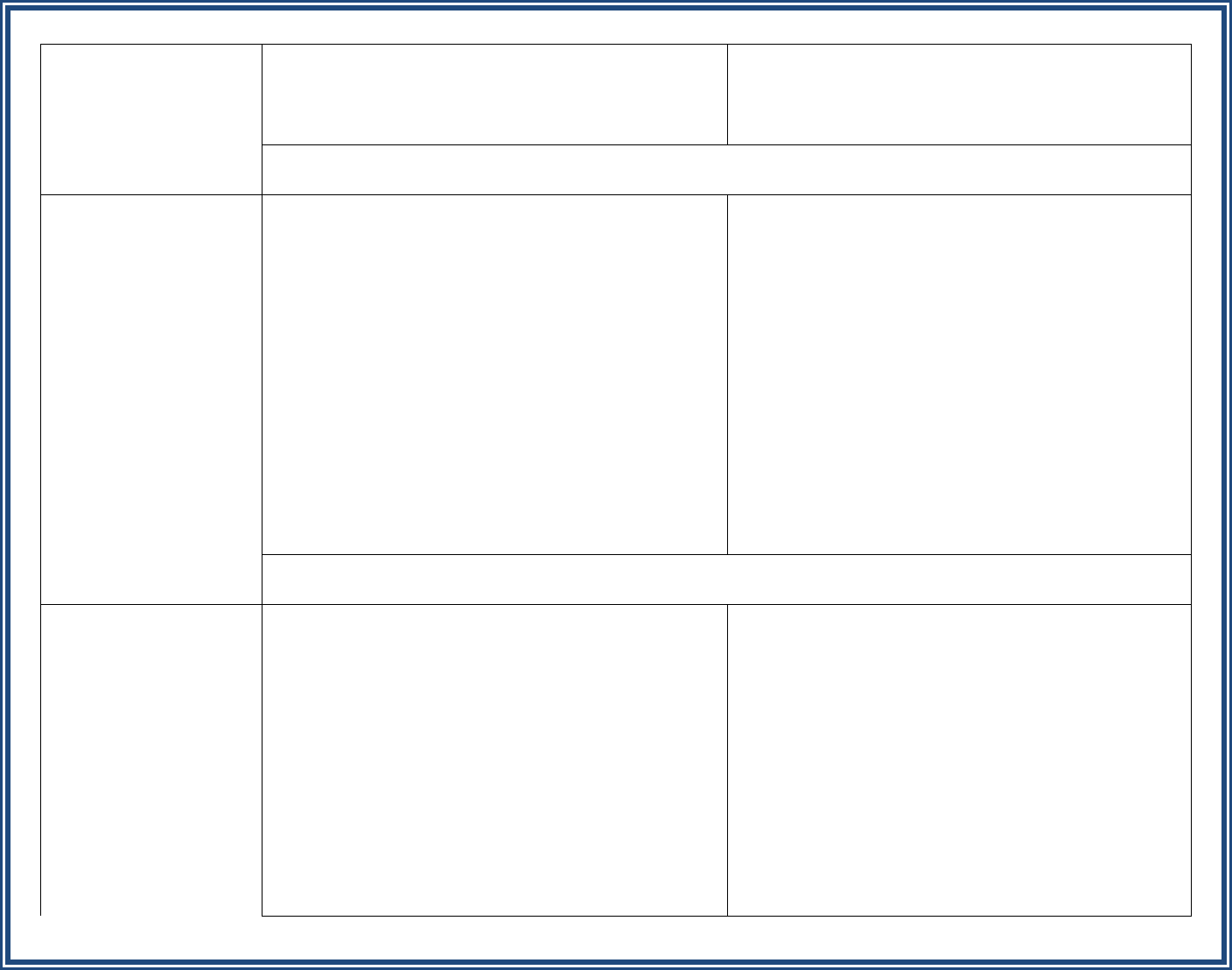
students receiving special education
•
2.3.3 Planning and preparing for the needs of
students who come from home environments
that offer little support for schooling
Commonalities and
Conclusions:
Teachers should analyze assessment data and other information to establish an understanding of
students’ background and prior knowledge to align rigorous learning goals.
b. Designs and aligns
formative and
summative
assessments that
match learning
objectives and lead to
mastery
Domain 1: Classroom Strategies and Behaviors
•
RE 1 Providing clear learning goals and
scales
• RE 2 Tracking student progress
• RE 3 Celebrating success
Domain 2: Planning and Preparing
• 2.1.1 Planning and preparing for effective
scaffolding within lessons
• 2.1.2 Planning and preparing for lessons
within units that progress toward a deep
understanding and transfer of content
•
2.1.3 Planning and preparing for appropriate
attention to established content standards
1f Designing Student Assessments
•
Congruence with instructional outcomes
• Criteria and standards
• Design of formative assessments
Commonalities and
Conclusions:
Teachers should design formative and summative assessments based on standards prior to instruction to
match the learning goal to achieve mastery.
c. Uses a variety of
assessment tools to
monitor student
progress, achievement
and learning gains
Domain 1: Classroom Strategies and Behaviors
•
RE 1 Providing clear learning goals and scales
• RE 2 Tracking student progress
• RE 3 Celebrating success
• C 5 Processing new information
• C 7 Recording and representing knowledge
• C12 Examining similarities and differences
• C 17 Engaging students in cognitively complex
tasks involving hypothesis generation and
testing
•
EOS 2 Using academic games
• EOS 3 Managing response rates
3d Using Assessment in Instruction
•
Assessment criteria
• Monitoring of student learning
• Feedback to students
• Student self-assessment and monitoring of
progress
23
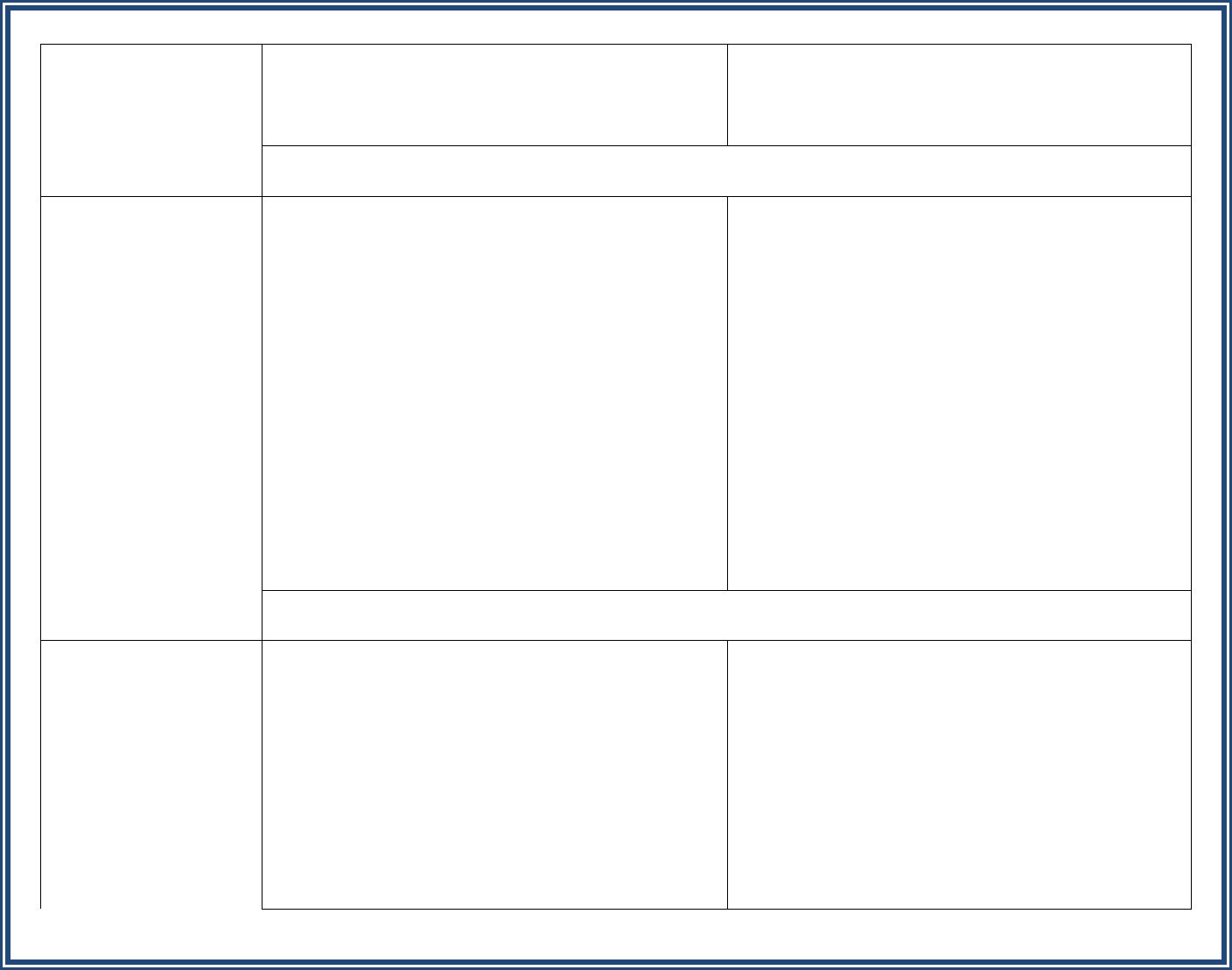
• EOS 18 Probing incorrect answers with low
expectancy students
•
EOS 17 Asking questions of low expectancy
students
Commonalities and
Conclusions:
Teachers should use a variety of ongoing assessments to monitor student mastery of learning objectives.
d. Modifies
assessments and
testing conditions to
accommodate
learning styles and
varying levels of
knowledge
Domain 1: Classroom Strategies and Behaviors
•
EOS 1 Noticing when students are not
engaged
• EOS 3 Managing response rates
• EOS 4 Using physical movement
• EOS 5 Maintaining a lively pace
• EOS 8 Provide opportunities for students to
talk about themselves
• EOS 13 Understanding students' interests and
backgrounds
Domain 2: Planning and Preparing
• 2.3.3 Planning and preparing for the needs of
students who come from home environments
that offer little support for schooling
1f Designing Student Assessments
•
Congruence with instructional outcomes
• Criteria and standards
• Design of formative assessments
3d Using Assessment in Instruction
• Assessment criteria
• Monitoring of student learning
• Feedback to students
• Student self-assessment and monitoring of
progress
3e Demonstrating Flexibility and Responsiveness
• Lesson adjustment
•
Response to students
• Persistence
Commonalities and
Conclusions:
Teachers should use differentiated instruction and adjust the formative assessments as needed
throughout the lesson in order to prepare all learners to reach mastery on the summative assessment.
e. Shares the
importance and
outcomes of student
assessment data with
the student and the
student's
parents/caregiver(s)
Domain 1: Classroom Strategies and Behaviors
•
RE 1 Providing clear learning goals and scales
• RE 2 Tracking student progress
• RE 3 Celebrating success
• EOS 3 Managing response rates
Domain 4: Collegiality and Professionalism
• 4.1.2 Promoting positive interactions with
students and parents
3d Using Assessment in Instruction
•
Assessment criteria
• Monitoring of student learning
• Feedback to students
• Student self-assessment and
• Monitoring of progress
4c Communicating with Families
• Information about the instructional program
•
Information about individual students
•
Engagement of families in the instructional
24
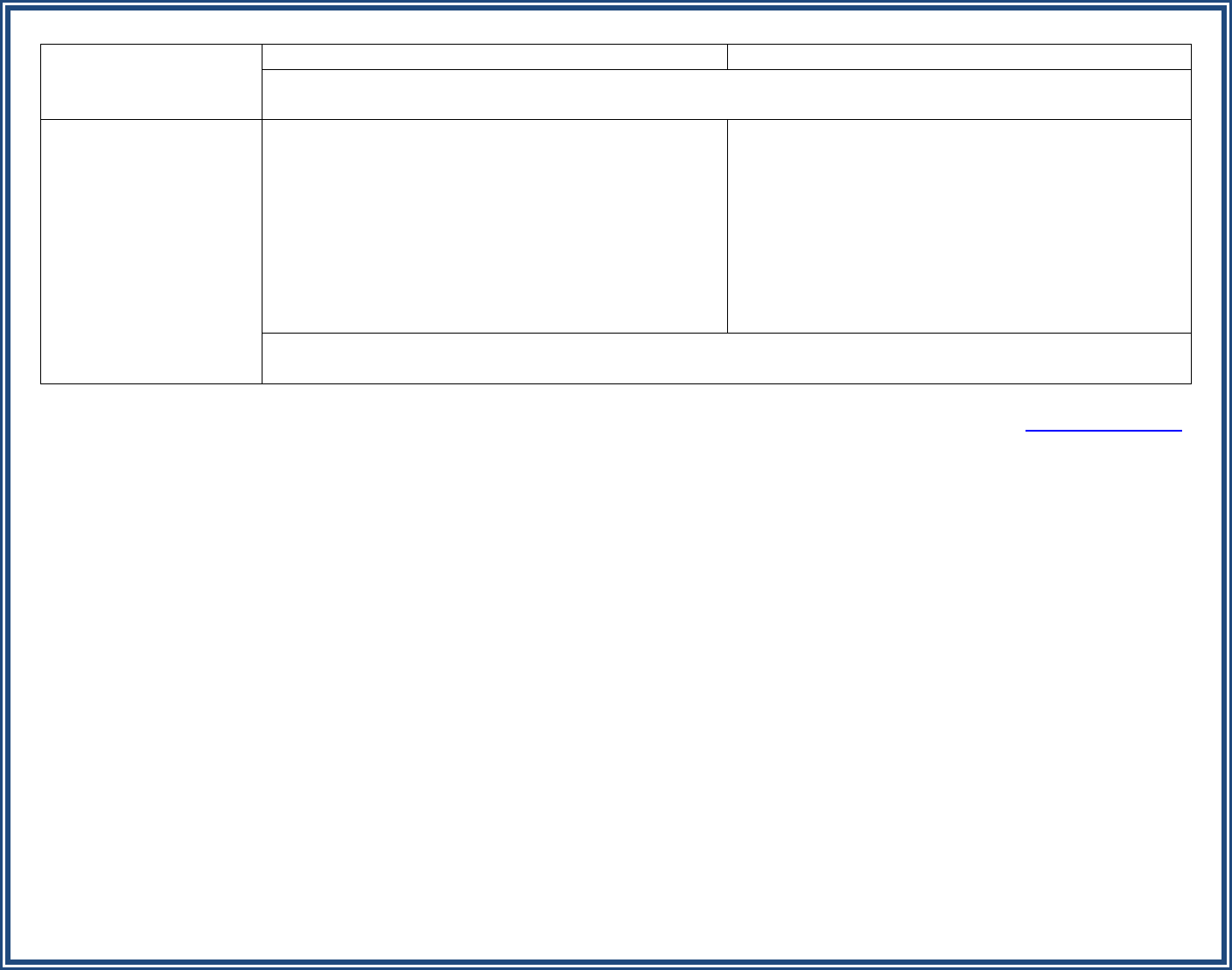
program
Commonalities and
Conclusions:
Teachers should provide continuous feedback to students and families on priority learning targets and
the student progress towards mastery of learning objectives.
f. Applies technology
to organize and
integrate assessment
information
Domain 2: Planning and Preparing
•
2.2.1 Planning and preparing for the use of
available traditional resources for upcoming
units and lessons (e.g., manipulatives, video
tapes)
• 2.2.2 Planning for the use of available
technology such as interactive white boards,
voting technologies and one-to-one computer
Technology is a common theme reflected in
Domain 1 (Planning and Preparation), Domain 3
(Instruction), and Domain 4 (Professional
Responsibilities).
4b: Maintaining Accurate Records
• Student completion of assignments
•
Student progress and learning
• Instructional records
Commonalities and
Conclusions:
Teachers should use technology tools for planning, designing, monitoring, analyzing and communicating
assessment data with students, families and colleagues.
Table of Contents
25
